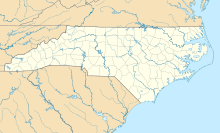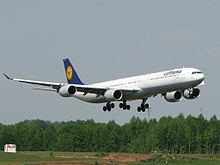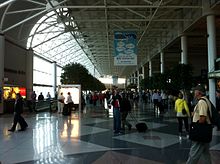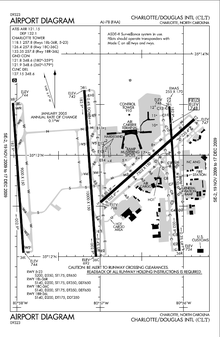- Charlotte/Douglas International Airport
-
This article is about the airport in Charlotte, North Carolina. For municipal airports with the same name, see Douglas Municipal Airport (disambiguation). For international airports with the same name, see Douglas International Airport (disambiguation).
Charlotte Douglas International Airport 
IATA: CLT – ICAO: KCLT – FAA LID: CLT Summary Airport type Public Owner City of Charlotte Operator Charlotte, North Carolina Serves Charlotte metropolitan area Location Charlotte, North Carolina, USA Hub for US Airways Elevation AMSL 748 ft / 228 m Coordinates 35°12′50″N 080°56′35″W / 35.21389°N 80.94306°WCoordinates: 35°12′50″N 080°56′35″W / 35.21389°N 80.94306°W Website Map Location within North Carolina Runways Direction Length Surface ft m 18L/36R 8,676 2,644 Asphalt/Concrete 18C/36C 10,000 3,048 Concrete 18R/36L 9,000 2,743 Concrete 5/23 7,502 2,287 Asphalt/Concrete Statistics (2010) Passengers 38,143,078 Aircraft operations 549,101 Source: Passenger statistics from CLT[1] Charlotte Douglas International Airport (IATA: CLT, ICAO: KCLT, FAA LID: CLT) is a joint civil-military public international airport located in Charlotte, North Carolina. Established in 1935 as Charlotte Municipal Airport, in 1954 the airport was renamed Douglas Municipal Airport after former Charlotte mayor Ben Elbert Douglas, Sr. The airport gained its current name in 1982 and is currently US Airways' largest hub, with service to 155 domestic and international destinations as of 2008.[2] In 2009, it was the 11th busiest airport in the United States[3] and in 2010, the 25th busiest airport in the world by passenger traffic.[4] In 2010, it was the 7th busiest airport in the world, based on traffic movements.
Contents
History
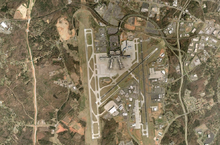 United States Geological Survey (USGS) aerial image
United States Geological Survey (USGS) aerial image
The early years
The city received a $200,000 grant from the Works Progress Administration (WPA) in 1930 to establish Charlotte's first municipal airport.
In 1936, the Charlotte Municipal Airport opened and was operated by the City of Charlotte. Eastern Air Lines began its first regularly scheduled passenger service in 1937. The original passenger terminal is still at the airport, and is now used as Fenway Sports Group's Boeing 727 parking area. (FSG's North American motorsport venture, Roush Fenway Racing, is based in the old terminal).
The United States Army Air Forces took control of the airport and established Morris Field Air Base in 1941. The airfield was used by the Third Air Force for antisubmarine patrols and training.
1950 to mid-1960s: into the jet age
In 1950 Eastern Airlines began regularly scheduled passenger service from CLT. In 1954, a 70,000-square-foot (6,500 m2) passenger terminal opened, and the airport was renamed Douglas Municipal Airport in honor of former Charlotte Mayor Ben Elbert Douglas, Sr. The terminal had two floors, although passenger operations were confined to the ground floor. Ticketing and baggage claim were located on each side of an open space which bisected the building from north to south, and a mezzanine restaurant and various airline offices overlooked this open space. Delta Air Lines began regularly scheduled passenger service in 1956. The OAG for April 1957 shows 57 weekday departures on Eastern, 7 Piedmont, 6 Capital, 4 Delta and 2 Southern.
Eastern Air Lines began the region's first regularly scheduled jet service with the Boeing 720 in 1962. Eastern used the west pier, Piedmont and Delta the center pier, and United and Southern used the east pier.
Late 1960s to 1978: growth pre-deregulation
A major renovation project in the late 1960s expanded the facility considerably. Eastern opened a 'unit terminal' in 1967, replacing the old west pier. This new facility had 8 dedicated gates for Eastern, each with its own departure lounge, as well as a snack bar and separate baggage claim space. Eastern passengers continued to check in at the main terminal.
Two years later in 1969, a new enclosed concourse was built parallel to the center pier. When it was completed, Piedmont, Eastern and Delta moved in and the old center pier was demolished. The new concourse also had separate departure lounges, as well as restrooms and an enlarged baggage claim area. United's flights continued to the use the east pier, although an enclosed holdroom was added for waiting passengers.
In 1973, Eastern added two more gates to the end of its west concourse.
1978 to 1989: becoming a major hub
After airline deregulation in 1978, passenger numbers at the terminal nearly doubled between 1978 and 1980, and a new 10,000-foot (3,000 m) parallel runway and control tower were opened in 1979 to handle the increased passenger loads. The airport's master plan also called for construction of a new terminal across the runway from the existing site. Ground for this expansion was broken in 1979.
In 1979, Piedmont Airlines dedicated Charlotte as the hub for its rapidly expanding route network. To accommodate the booming growth of the facility, a new 325,000-square-foot (30,200 m2) passenger terminal opened in 1982, and the airport was renamed Charlotte Douglas International Airport. In 1987, Piedmont inaugurated non-stop service to London.
In the mid-1980s, the old terminal site was converted in to a cargo center, and the central concourse and Eastern 'unit terminal' were removed to make way for larger, more modern cargo buildings. The original main building still stands, however, and is used for office space. The old control tower was removed in the late 1990s.
In 1989, Piedmont merged with USAir, the new merged operations kept the USAir name.
1990 to 2004: the influence of US Airways
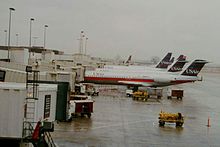 US Airways jets at CLT in 1998 in the former USAir livery
US Airways jets at CLT in 1998 in the former USAir livery
In 1990, a new 80,000-square-foot (7,400 m2) international and commuter concourse opened, and in 1991 further expansion of the terminal buildings continued, reflective of USAir's dominating presence at the airport. A monumental bronze statue of Queen Charlotte of Mecklenburg-Strelitz (the namesake of the city), created by Raymond Kaskey, was placed in front of the main terminal.
In 1992, Lufthansa began Boeing 747 service to Germany; however, this service was discontinued shortly thereafter. In 1994, British Airways began service to London via a "global alliance" with USAir. This has since been discontinued, as the airlines have chosen opposite alliances. Lufthansa did restart service to Charlotte in 2003 and now operates flights between Charlotte and Munich, Germany utilizing Airbus A340-600 and Airbus A330-300 aircraft.
When USAir became US Airways in 1996, Charlotte remained its largest hub in terms of passenger traffic, and in 1999, plans were announced for the construction of a regional carrier concourse (present-day Concourse E) and for the expansion of Concourses A and D.
In 2002, the new 32-gate Concourse E opened,[5] and US Airways also began non-stop service to Belize, Freeport, Providenciales, Punta Cana, and St. Croix.
In 2003, the main ticketing hall was expanded to the east, providing 13 additional ticketing counters and a new security checkpoint; and Concourse D was expanded by an additional 9 gates. That year, US Airways began service to Costa Rica, Mexico City, and St. Kitts. Lufthansa also returned to the airport at this time providing service to Munich.
2005 and beyond
Following America West Airlines' acquisition of US Airways in a reverse takeover,[6] Charlotte (CLT) remains the primary domestic hub for the airline. However, the majority of US Airways' international routes are served out of the airline's second-largest hub, Philadelphia. In April 2007, Charlotte was the fastest growing airport in the US. [7] and is among the 30 busiest airports in the world in terms of passenger traffic.[citation needed]
Construction
Construction of Charlotte International's fourth runway began in the spring of 2007. At 9,000 feet (2,700 m) long, the new "third parallel" will allow three independent approaches for arrivals even from the south, potentially increasing capacity by 33 percent. This new runway lies west of the three existing runways. The construction of the fourth runway required the relocation of parts of Wallace Neel Road (which had previously formed the Western boundary of the airport) to an alignment located further to the west.
Construction involved two phases. The first phase, which began in March 2007, included grading and drainage. The second phase included the paving and lighting of the runway. In August 2009, crews paved the last section.[8]
On the morning of November 20, 2008 runway 18R/36L was changed to runway 18C/36C in anticipation of the upcoming commissioning of the new third parallel runway which would carry the 18R/36L designation when opened.
The runway opened January 6, 2010. The cost for the runway and taxiways was $325 million, with the federal government paying $124 million and the rest funded by a $3 fee added to the cost of a ticket.[9]
The new runway was initially operational for visual approaches only, but is since February 11, 2010 approved for instrument approaches as well. The Runway construction also has planned to reroute several roads around the airport. Within these plans, a new interchange at the I-485 Outerbelt is planned to connect the airport and another relocated road.
As a part of a large-scale program to renew the airport, on June 29, 2009, the red "Welcome to Charlotte" sign at the passenger and main entrance of the airport, on Josh Birmingham Parkway, has been repainted blue and gray.
The airport plans to extend Concourse E by 120 feet (37 m) to accommodate additional aircraft. Unlike the rest of Concourse E, this new portion will have 2 levels to accommodate larger CRJs and A320s.
In addition, construction of a new International Terminal will begin in 2012, and Concourse E is planned to be disconnected to the main terminal, and would then be accessible by underground walkway. A shuttle will be built connecting the terminals, parking garages, rental car center, and eventually, light rail.
On September 28, 2010 construction officially began to expand the ticket counter area connecting it to Concourse E eventually making room for one more Security checkpoint area.
Parking
The parking options at Charlotte Douglas have drastically improved in recent years. There have been two new Daily Parking decks erected since 2005, providing almost 6,000 additional parking spaces for the traveling public. There are also two Long Term lots, with a combined 6,500 spaces. In addition, there is the Remote lot, which is between the Daily and Long Term lots, with about 1,500 spaces. A new 40-million-dollar Business Valet Parking Deck, which will utilize Post Tension Concrete for each massive 250,000-square-foot (23,000 m2) level, has now opened. Charlotte's close-in surface and deck parking exits are serviced by part-time personnel from booths apparently dating to the 1982 terminal expansion. The Daily parking rates at CLT are some of the lowest in the nation, with Long Term costing $4 & Remote parking costing $6 per day (Remote parking is closed as of January 5, 2009 for an unknown length of time). Daily Parking is $6 per day, and Hourly $2 per hour with a maximum charge of $16 per day. Hourly also allows the first 30 minutes of parking free of charge. Staff audits every parking area each evening to upload license plate data to ensure each vehicle is assessed the correct parking fee when it exits. The airport has recently aligned with a customer service program called SmartPark, which allows customers to call a hotline 24 hours a day to receive updates on parking conditions. Charlotte Douglas also has Valet parking that provides vehicle washing and detailing and even paintless dent removal services for an additional charge.
The Overlook
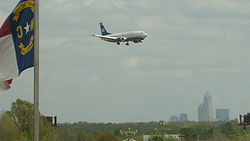 A US Airways Boeing 737-300 landing at Charlotte Douglas International Airport in April 2008 with the Charlotte skyline in the background.
A US Airways Boeing 737-300 landing at Charlotte Douglas International Airport in April 2008 with the Charlotte skyline in the background.
Charlotte-Douglas International Airport is one of the few airports in the US that has a public viewing area. Here, visitors can watch planes take off, land, and taxi to and from runway 18C/36C. It is credited with having one of the best airport views in the United States.
Carolinas Aviation Museum
Main article: Carolinas Aviation MuseumCharlotte-Douglas International Airport is one of a small number of major "hub" airports in the world which has an aviation museum located on the field. The Museum, established in 1992, has a collection of over 50 aircraft, including a flying DC-3 which is painted in Piedmont Airlines livery. The Museum also has an aviation library with over 9,000 volumes and a very extensive photography collection. Rare aircraft in the collection include one of only two surviving Douglas D-558 Skystreak aircraft, and the second (and oldest surviving) US-built Harrier, which was used as the flight-test aircraft and accumulated over 5,000 flight-test hours.
In January 2011 the Museum acquired N106US, the US Airways Airbus A-320 which Capt. Sullenberger landed in the Hudson River on January 15, 2009. This aircraft, which was delivered on June 10, 2011, is about 35 years younger than any other commercial airliner on display in a museum, gives the museum an unparalleled technological lead over other aviation museums in the field of commercial aviation.
Incidents and accidents
Accidents en route
- Thursday, January 15, 2009 US Airways Flight 1549 an Airbus A320, from LaGuardia Airport in New York, NY to Seattle-Tacoma International Airport in Seattle via Charlotte made an emergency landing in the Hudson River after geese struck and disabled both of the engines. On January 5, 2011 the New York Times reported that the airframe will be placed on display at the Carolinas Aviation Museum.
Incidents
- On September 11, 1974, Eastern Air Lines Flight 212 crashed on final approach en route from Charleston, SC. The crash site is 3.3 miles (5.3 km) due south of what is now Runway 36R west of York Road and north of Thornfield Road. The NTSB determined that the probable cause of the accident was a "lack of altitude awareness" of the pilots at critical points during the approach. During the approach the pilots conversed about numerous non-operational topics. With pilot attention drawn outside the aircraft, altitude "call outs" were neglected. With foggy treetops in sight, the pilot pulled back sharply and went to full throttle. The DC-9-31, traveling over 200 mph, clipped trees and snapped its wings, rupturing fuel tanks that spilled 13,000 pounds (5,900 kg) of Jet A fuel. The fiery airliner slid through dense woods into a ravine, broke into pieces, and came to rest with most of its cabin exit doors blocked by pine trees. The Steele Creek Volunteer Fire Department responded quickly, extinguishing the fire within minutes. Of 82 people onboard, 13 survived the crash and fire. Two passengers died several days later, and a third died 29 days after the crash. Stephen Colbert, host of The Colbert Report on Comedy Central, lost his father and two brothers in the accident. Many passengers were wearing stylish "double-knit" garments that adhered to the skin when burned.[10]
- On October 25, 1986, Piedmont Airlines Flight 467 overran the runway at Charlotte-Douglas Airport. The airplane was damaged beyond repair. Of the 119 people on board, 3 passengers sustained serious injuries, and 3 crewmembers and 28 passengers sustained minor injuries in the incident. There were no fatalities.[11]
- On 19 January 1988, a Mountain Air Cargo De Havilland Canada DHC-6 Twin Otter 200 (N996SA), on a flight from Erie, Pennsylvania to Charlotte, descended below the glide path on approach to Charlotte Douglas International Airport, collided with a tree and struck the ground 1.6 km away from the airport. The crash was due to pilot error. The pilot was killed. There was no one else on board.[12]
- On July 2, 1994, USAir Flight 1016 crashed in a residential area on approach, killing 37. The crash of the DC-9 was attributed to windshear during a thunderstorm. The flight originated in Columbia, South Carolina.
- On January 8, 2003, US Airways Express Flight 5481 crashed at the airport, killing all 21 people aboard. The flight was operated by Air Midwest, an independent airline operating under a US Airways Express codesharing agreement.
- On May 29, 2009, a runway incursion occurred on Runway 18L between US Airways Express Flight 2390, a CRJ-200, and a general aviation Pilatus PC-12 turboprop. While Flight 2390 was on its takeoff roll, the general aviation aircraft was instructed to taxi into position and hold on the same runway for an intersection departure. The aircraft came within 10 feet of each other. There were no injuries.[13]
- On August 28, 2010, US Airways Express flight 2455 traveling from Washington DC to Nashville TN, was diverted to Charlotte NC after a windshield cracked, of the 14 passengers and 3 crew members no one was hurt.
- On Monday, March 28, 2011, a US Airways Boeing 737-400, flying from Philadelphia to Charlotte, appeared to have a bullet hole in the side of the fuselage. The bullet did not pierce through into the cabin and no injuries were reported.[citation needed]
Concourses, airlines and destinations
- Concourse A
- Concourse A has 12 Gates, and is the only concourse not used by US Airways
- Concourse B
- Concourse B has 16 Gates
- Concourse C
- Concourse C has 18 Gates
- Concourse D
- Concourse D has 13 Gates and serves as the international concourse. All international arrivals without customs preclearance are handled at this facility
- Concourse E
- Concourse E has 32 Gates, and is mainly used for US Airways Express
Airlines Destinations Concourse Air Canada Express operated by Jazz Air Toronto-Pearson A(4) AirTran Airways Atlanta, Baltimore, Orlando A(6,8) American Airlines Dallas/Fort Worth A(9,11) American Eagle Chicago-O'Hare, Miami, New York-LaGuardia A(9,11) Continental Airlines Houston-Intercontinental, Newark A(10,12) Continental Express operated by Chautauqua Airlines Cleveland A(10,12) Continental Express operated by ExpressJet Airlines Cleveland, Houston-Intercontinental, Newark A(10,12) Delta Air Lines Atlanta, Detroit, Memphis, Minneapolis/St. Paul, Salt Lake City [begins March 3, 2012] A(1,3,5,7) Delta Connection operated by Atlantic Southeast Airlines Atlanta, Detroit, Memphis A(1,3,5,7) Delta Connection operated by Chautauqua Airlines New York-JFK A(1,3,5,7) Delta Connection operated by Comair Cincinnati/Northern Kentucky A(1,3,5,7) Delta Connection operated by Compass Airlines Minneapolis/St. Paul A(1,3,5,7) Delta Connection operated by Pinnacle Airlines Cincinnati/Northern Kentucky, Detroit, Memphis, New York-JFK A(1,3,5,7) Insel Air Curacao D(6) JetBlue Airways Boston, New York-JFK D(4) Lufthansa Munich D(12) United Airlines Chicago-O'Hare A(2,4) United Express operated by ExpressJet Airlines Chicago-O'Hare, Washington-Dulles A(2,4) United Express operated by Mesa Airlines Chicago-O'Hare, Washington-Dulles A(2,4) United Express operated by Shuttle America Newark A(10.12) United Express operated by SkyWest Airlines Houston-Intercontinental A(10,12) US Airways Albany, Allentown/Bethlehem, Antigua, Aruba, Atlanta, Baltimore, Barbados, Belize City, Birmingham (AL), Boston, Buffalo, Cancun, Charleston (SC), Chicago-O'Hare, Cleveland, Columbus (OH), Cozumel, Dallas/Fort Worth, Denver, Detroit, Fort Lauderdale, Fort Myers, Frankfurt, Freeport, Grand Cayman, Greensboro, Harrisburg, Hartford/Springfield, Houston-Intercontinental, Indianapolis, Jacksonville (FL), Kansas City, Las Vegas, Liberia (CR), London-Gatwick, Los Angeles, Memphis, Mexico City, Miami, Minneapolis/St. Paul, Montego Bay, Myrtle Beach, Nashville, Nassau, New Orleans, New York-JFK, New York-LaGuardia, Newark, Norfolk/Virginia Beach, Orlando, Paris-Charles De Gaulle, Philadelphia, Phoenix, Pittsburgh, Portland (ME), Providence, Providenciales, Punta Cana, Raleigh/Durham, Richmond, Rio de Janeiro-Galeao, Rochester (NY), Rome-Fiumicino, St Croix, St Kitts, St Lucia, St Maarten, St. Louis, St. Thomas, Salt Lake City [begins March 4, 2012][14], San Antonio, San Diego, San Francisco, San Jose de Costa Rica, San Jose del Cabo, San Juan, Seattle/Tacoma, Syracuse, Tampa, Washington-National, West Palm Beach, Wilmington (NC)
Seasonal: Bermuda, Daytona Beach, Dublin, Madrid, Portland (OR), Sacramento, Washington-DullesB(1–16), C(2–19), D(1–3,5,7–13) US Airways Express operated by PSA Airlines Akron/Canton, Allentown/Bethlehem, Asheville, Atlanta, Augusta (GA), Baltimore, Baton Rouge, Birmingham (AL), Blountville/Tri-Cities, Buffalo, Charleston (SC), Charleston (WV), Charlottesville, Chattanooga, Cincinnati/Northern Kentucky, Cleveland, Columbia (SC), Columbus (OH), Dayton, Daytona Beach, Fayetteville (AR), Fayetteville (NC), Fort Walton Beach, Gainesville, Greensboro, Greenville (NC), Greenville/Spartanburg (SC), Gulfport/Biloxi, Harrisburg, Hartford, Huntsville, Indianapolis, Jackson, Jacksonville (FL), Jacksonville (NC), Knoxville, Lexington, Little Rock, Louisville, Melbourne (FL), Mobile, Montgomery, Myrtle Beach, Nashville, New Bern, Newport News/Williamsburg, New York-LaGuardia, Norfolk/Virginia Beach, Pensacola, Raleigh/Durham, Richmond, Roanoke, St. Louis, Sarasota/Bradenton, Savannah, Tallahassee, Washington-Dulles, Washington-National, White Plains, Wilkes-Barre/Scranton, Wilmington (NC)
Seasonal: FreeportE(1–38) US Airways Express operated by Republic Airlines Albany, Atlanta, Baltimore, Birmingham (AL), Buffalo, Charleston (SC), Chicago-O'Hare, Cleveland, Columbus (OH), Detroit, Greensboro, Houston-Intercontinental, Indianapolis, Jacksonville (FL), Kansas City, Manchester (NH), Memphis, Minneapolis/St. Paul, Montréal-Trudeau, Myrtle Beach, Nashville, New Orleans, New York-LaGuardia, Norfolk/Virginia Beach, Ottawa, Pittsburgh, Providence, Raleigh/Durham, Richmond, Rochester (NY), St. Louis, Sarasota/Bradenton, Savannah, Syracuse, Toronto-Pearson, Washington-National, Wilmington (NC)
Seasonal: Key WestC(2–6,8–16,19) US Airways Express operated by Air Wisconsin Allentown/Bethlehem, Charleston (SC), Charleston (WV), Chattanooga, Cincinnati/Northern Kentucky, Cleveland, Fayetteville (NC), Florence (SC), Greensboro, Greenville/Spartanburg (SC), Huntsville, Indianapolis, Jacksonville (NC), Lexington, Louisville, Melbourne (FL), Milwaukee, Montreal-Trudeau, Myrtle Beach, Norfolk, Ottawa, Raleigh/Durham, Richmond, Savannah, St. Louis, Toronto-Pearson, Washington-Dulles, Washington-National, White Plains, Wilmington (NC) E(1–38) US Airways Express operated by Chautauqua Airlines Columbus (OH), Greensboro, Greensville/Spartanburg (SC), Louisville, New Bern E(1–38) US Airways Express operated by Mesa Airlines Austin, Birmingham (AL), Charleston (SC), Cincinnati/Northern Kentucky, Cleveland, Detroit, Fayetteville (NC), Harrisburg, Jacksonville (FL), Kansas City, Knoxville, Louisville, Little Rock, Memphis, Myrtle Beach, Nashville, New Orleans, New York-LaGuardia, Newark, Norfolk/Virginia Beach, Pensacola, Raleigh/Durham, St. Louis, San Antonio, Savannah, Washington-Dulles, Wilmington (NC)
Seasonal: Daytona BeachE(1–38) US Airways Express operated by Piedmont Airlines Asheville, Augusta (GA), Blountville/Tri-Cities, Charleston (SC), Charleston (WV), Charlottesville, Chattanooga, Columbia (SC), Florence (SC), Greensboro, Greenville (NC), Greenville/Spartanburg (SC), Hilton Head, Huntington (WV), Jacksonville (NC), Lynchburg, New Bern, Newport News/Williamsburg, Richmond, Roanoke, Salisbury (MD), Washington-Dulles E(1–38) Airline Lounges
US Airways Club: Concourses B and C/D connector USO Lounge: Atrium
There was an additional US Airways Club located in Concourse D, which was closed due to US Airways costcutting. British Airways also operated a lounge in the Main Atrium, which became a USO Lounge after they canceled service to Charlotte.
Cargo Airlines
Airlines Destinations Terminal Air Transport International Baltimore, Philadelphia Cargo Capital Cargo International Airlines Fort Lauderdale, Toledo Cargo FedEx Express Indianapolis, Memphis Cargo UPS Airlines Louisville Cargo Top destinations
Busiest Domestic Routes from CLT (August 2010 – July 2011)[15] Rank City Passengers Carriers 1  Atlanta, GA
Atlanta, GA759,000 AirTran, Delta, US Airways 2  Dallas/Fort Worth, TX
Dallas/Fort Worth, TX558,000 American, US Airways 3  New York, NY (LGA)
New York, NY (LGA)553,000 American, US Airways 4  Chicago, IL
Chicago, IL524,000 American, United, US Airways 5  Boston, MA
Boston, MA484,000 JetBlue, US Airways 6  Orlando, FL
Orlando, FL468,000 AirTran, US Airways 7  Newark, NJ
Newark, NJ459,000 Continental, United, US Airways 8  Baltimore, MD
Baltimore, MD454,000 AirTran, US Airways 9  Phoenix, AZ
Phoenix, AZ416,000 US Airways 10  Philadelphia, PA
Philadelphia, PA403,000 US Airways Reliever airports
Ground transportation
- Sprinter Enhanced Bus Service (City Bus – See below)
- Taxi
- Hotel Shuttles
- Car Rentals
CATS' Sprinter Enhanced Bus Service connects the airport to the downtown Charlotte Transportation Center (this route was formerly known as the "Route 5-Airport"). It arrives and departs in front of Zone D Baggage Claim in the commercial lanes, and is easily identifiable by its green livery and "Sprinter" decals.
The service is operated from the airport every 20 minutes Monday–Friday from 5:50am to 7:00pm, after 7:00pm, service is offered every 30 minutes until 12:02am. On Saturday and Sunday, Sprinter operates from the airport every hour from 6:00am to 8:00am, every half-hour from 8:00am to 9:00pm, and every hour from 9:00pm to 1:00am. Trip time from the airport to downtown is approx. 20 minutes (depending on traffic conditions) and one-way fare is $1.75 (this is the same as all local routes in the CATS system). View the Sprinter Schedule for more detailed schedule and route information.
Military facilities
Charlotte/Douglas International Airport is also home to the USO of NC (United Service Organization of North Carolina) travel center which functions as an airport lounge for military personnel, military retirees and their families. Staffed by volunteers, the centers offer comfortable chairs, books, magazines, television, movies, video games, kid play areas, and refreshments. Internet and phone use available free of charge
Notes
- ^ Passenger statistics for CLT
- ^ "Charlotte Faces Loss of Hub Status and Potential for Big Service Cuts". The Charlotte Observer. http://www.airportbusiness.com/article/article.jsp?id=8959&siteSection=35. Retrieved 2008-01-01. "Because Delta's main hub, Atlanta Hartsfield-Jackson International Airport, is only 240 miles (390 km) from Charlotte, a US Airways-Delta merger is a particular worry for Charlotte, which has nonstop service to 135 cities -- a high number for a city its size."
- ^ http://www.transtats.bts.gov/airports.asp?pn=1&Airport=CLT&Airport_Name=Charlotte,%20NC:%20Charlotte%20Douglas%20International&carrier=FACTS. The Bureau of Transportation Statistics
- ^ "US Airways defying US trends with healthy growth at its main Charlotte hub". anna.aero. 5 September 2008. http://www.anna.aero/2008/09/05/us-airways-defying-us-trends-with-healthy-growth-at-its-main-charlotte-hub/.
- ^ "Fast Facts". Charlotte Douglas International Airport. The City of Charlotte. http://www.charmeck.org/Departments/Airport/About+CLT/Fast+Facts.htm.
- ^ "SEC Edgar doc". http://www.sec.gov/Archives/edgar/data/701345/000095012305011287/p70803a2sv1za.htm#134.
- ^ "Fastest Growing". USA Today. April 19, 2007. http://www.usatoday.com/travel/flights/2007-04-18-charlotte-airport-is-fastest-growing_N.htm. Retrieved April 28, 2010.
- ^ http://www.charmeck.org/Departments/Airport/Runway+Road+Relocations.htm
- ^ Harrison, Steve (2010-01-07). "Airport opens 4th runway". The Charlotte Observer. http://www.charlotteobserver.com/breaking/story/1165089.html. Retrieved 2010-01-26.
- ^ "Eastern 212 Accident Report" (PDF). National Transportation Safety Board. 1975-05-23. http://libraryonline.erau.edu/online-full-text/ntsb/aircraft-accident-reports/AAR75-09.pdf.
- ^ http://www.fss.aero/accident-reports/look.php?report_key=195
- ^ "Accident description". http://aviation-safety.net/database/record.php?id=19880119-0. Retrieved 2006-11-26.
- ^ "Runway Incursion Incident at CLT". Aviation Today. 2009-06-08. http://www.aviationtoday.com/asw/topstories/Runway-Incursion-Incident-at-CLT_32714.html.
- ^ http://www.airlinedaily.com/feeds.html#http://us.rd.yahoo.com/finance/news/rss/story/*http://biz.yahoo.com/bw/111107/20111107005543.html?.v=1
- ^ http://www.transtats.bts.gov/airports.asp?pn=1&Airport=CLT&Airport_Name=Charlotte,%20NC:%20Charlotte%20Douglas%20International&carrier=FACTS
References
External links
- Official website
- NCDOT Airport Information: Charlotte Douglas International Airport PDF (312 KiB)
- FAA Airport Diagram (PDF), effective 20 October 2011
- Resources for this airport:
- AirNav airport information for KCLT
- ASN accident history for CLT
- FlightAware airport information and live flight tracker
- NOAA/NWS latest weather observations
- SkyVector aeronautical chart for KCLT
- FAA current CLT delay information
- Guide to WiFi access at Charlotte Douglas International Airport
- Amenity: The Front Porch Comes to the Airport
Asheville Regional Airport (Asheville) • Charlotte/Douglas International Airport (Charlotte) • Fayetteville Regional Airport (Fayetteville) • Piedmont Triad International Airport (Greensboro) • Pitt-Greenville Airport (Greenville) • Albert J. Ellis Airport (Jacksonville) • Coastal Carolina Regional Airport (New Bern) • Raleigh-Durham International Airport (Raleigh) • Wilmington International Airport (Wilmington)Current military installations of North CarolinaArmy  FortPortAir FieldMackall • SimmonsRange
FortPortAir FieldMackall • SimmonsRange
Marines  Air StationCampRangeLanding Field
Air StationCampRangeLanding FieldNavy  RangeBrant Island • Dare County • Piney Island • Stumpy Point
RangeBrant Island • Dare County • Piney Island • Stumpy PointAir Force  OtherAir Force Combat Climatology CenterCharlotte/Douglas
OtherAir Force Combat Climatology CenterCharlotte/DouglasCoast Guard  Cape Hatteras • Fort MaconStationElizabeth City • Emerald Isle • Fort Macon • Hattaras Inlet • Hobucken • Oak Island • Ocracoke • Oregon Inlet • Wrightville BeachSupport CenterElizabeth City
Cape Hatteras • Fort MaconStationElizabeth City • Emerald Isle • Fort Macon • Hattaras Inlet • Hobucken • Oak Island • Ocracoke • Oregon Inlet • Wrightville BeachSupport CenterElizabeth CityMajor airports of the United States Atlanta (Hartsfield–Jackson Atlanta International Airport – ATL) · Baltimore (Baltimore/Washington International Thurgood Marshall Airport – BWI) · Boston (Logan International Airport – BOS) · Charlotte (Charlotte/Douglas International Airport – CLT) · Chicago (O'Hare International Airport – ORD) · Dallas-Fort Worth (Dallas/Fort Worth International Airport – DFW) · Denver (Denver International Airport – DEN) · Detroit (Detroit Metropolitan Wayne County Airport – DTW) · Fort Lauderdale (Fort Lauderdale – Hollywood International Airport – FLL) · Honolulu (Honolulu International Airport – HNL) · Houston (George Bush Intercontinental Airport – IAH) · Las Vegas (McCarran International Airport – LAS) · Los Angeles (Los Angeles International Airport – LAX) · Miami (Miami International Airport – MIA) · Minneapolis – Saint Paul (Minneapolis-Saint Paul International Airport – MSP) · Newark (Newark Liberty International Airport – EWR) · New York (John F. Kennedy International Airport – JFK) · New York (LaGuardia Airport – LGA) · Orlando (Orlando International Airport – MCO) · Philadelphia (Philadelphia International Airport – PHL) · Phoenix (Phoenix Sky Harbor International Airport – PHX) · Salt Lake City (Salt Lake City International Airport – SLC) · San Diego (San Diego International Airport – SAN) · San Francisco (San Francisco International Airport – SFO) · Seattle (Seattle–Tacoma International Airport – SEA) · Tampa (Tampa International Airport – TPA) · Washington, D.C. (Ronald Reagan Washington National Airport – DCA) · Washington, D.C. (Washington Dulles International Airport – IAD)
 USAAF Third Air Force in World War II
USAAF Third Air Force in World War IIAirfields Group Training Stations · Replacement Training Stations · Tactical Airfields
Units Commands II Air Support Command · III Air Support Command · III Bomber Command · III Fighter Command · III Reconnaissance Command · III Tactical Air CommandDivisions III Tactical Air DivisionWings 8th Fighter Wing · 9th Fighter Wing · 40th Bombardment WingGroups Air Commando 2nd Air Commando · 3rd Air CommandoBombardment 3rd Bombardment · 12th Bombardment · 17th Bombardment · 21st Bombardment · 29th Bombardment · 30th Bombardment Group · 38th Bombardment · 44th Bombardment · 46th Bombardment · 47th Bombardment · 85th Bombardment · 88th Bombardment · 90th Bombardment · 91st Bombardment · 92nd Bombardment · 93rd Bombardment · 94th Bombardment · 95th Bombardment · 97th Bombardment · 98th Bombardment · 99th Bombardment · 100th Bombardment · 309th Bombardment · 310th Bombardment · 312th Bombardment · 319th Bombardment · 320th Bombardment · 321st Bombardment · 322d Bombardment · 323d Bombardment · 335th Bombardment · 336th Bombardment · 340th Bombardment · 344th Bombardment · 345th Bombardment · 386th Bombardment · 387th Bombardment · 391st Bombardment · 394th Bombardment · 396th Bombardment · 397th Bombardment · 409th Bombardment · 410th Bombardment · 411th Bombardment · 416th Bombardment · 417th Bombardment · 418th Bombardment · 451st Bombardment · 454th Bombardment · 463rd Bombardment · 483rd Bombardment · 488th BombardmentFighter 20th Fighter · 31st Fighter · 49th Fighter · 50th Fighter · 53rd Fighter · 54th Fighter · 56th Fighter · 59th Fighter · 79th Fighter · 80th Fighter · 81st Fighter · 84th Fighter · 85th Fighter · 311th Fighter · 332nd Fighter · 337th Fighter · 338th Fighter · 339th Fighter · 361st Fighter · 369th Fighter · 372nd Fighter · 404th Fighter · 405th Fighter · 408th Fighter · 414th Fighter · 506th FighterFighter-Bomber 27th Fighter-Bomber · 48th Fighter-Bomber · 86th Fighter-Bomber · 406th Fighter-Bomber · 407th Fighter-BomberReconnaissance 2d Reconnaissance · 9th Reconnaissance · 10th Reconnaissance · 26th Reconnaissance · 65th Reconnaissance · 67th Reconnaissance · 68th Reconnaissance · 69th Reconnaissance · 70th Reconnaissance · 75th Reconnaissance · 77th Reconnaissance · 423d Reconnaissance · 424th Reconnaissance · 426th ReconnaissanceUnited States Army Air Forces
First · Second · Third · Fourth · Fifth · Sixth · Seventh · Eighth · Ninth · Tenth · Eleventh · Twelfth · Thirteenth · Fourteenth · Fifteenth · TwentiethCategories:- Airports established in 1936
- Airports in North Carolina
- Transportation in Charlotte, North Carolina
- Transportation in Mecklenburg County, North Carolina
- Facilities of the United States Air National Guard
- Airfields of the United States Army Air Forces in North Carolina
- Airfields of the United States Army Air Corps
- Works Progress Administration in North Carolina
- Buildings and structures in Charlotte, North Carolina
Wikimedia Foundation. 2010.

